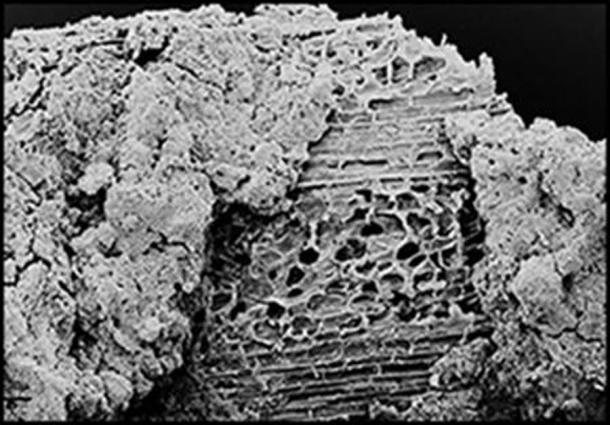A new study published in the journal Antiquity has revealed some surprising information about the inhabitants of the ancient city of Çatalhöyük, an early Neolithic settlement located in southern Anatolia (modern-day Turkey). It seems these industrious people found a way to convert fibers from oak trees into textiles that were used to make clothes. Based on the study’s results, the oak fiber textiles of Çatalhöyük are the oldest cloth artifacts, or the oldest preserved woven fabrics in the world.
This is just the latest discovery that highlights the accomplishments of the residents of this famous Stone Age city, which was founded around 9,500 years ago and remains one of the oldest urban enclaves found in the archaeological record.
Çatalhöyük Weavers Made The Oldest Cloth Artifacts Ever
Excavations have been ongoing in Çatalhöyük since the 1950s, and at the time was believed to have been the world’s first true city. Originally settled in about 7,500 BC, in the early Neolithic ( Chalcolithic) era, shortly after the end of the last ice age, Çatalhöyük may have been home to as many as 10,000 people at its peak of population.
Over the approximately 1,100 years the city was occupied, its residents built a culture that was quite sophisticated for the time.

Çatalhöyük after the first excavations by James Melaart and his team. ( CC BY-SA 3.0 )
Among other capacities, the people of Çatalhöyük were skilled and accomplished weavers. They produced ample supplies of baskets, ropes, mats, and clothing made from finely-woven materials, examples of which were recovered during excavations that tracked centuries of activity within the city’s confines. These woven artifacts are considered to be the oldest cloth artifacts ever found so far on Earth.
What was this Oldest Cloth Made From?
Archaeologists learned a lot about the Çatalhöyük weaving industry from studying such items. There was one thing they didn’t know about the weavers of Çatalhöyük, however, and that was about the type of material they used to make their clothing fabric.
In other ancient textile samples, scholars had identified wool from sheep and linen made from plant fibers harvested from flax, as the top candidates, based on the clothes-making practices of other ancient peoples.
To obtain a definitive answer for the material used to make the cloth at Çatalhöyük, a team of archaeologists with expertise in this area collaborated on a study of pieces of clothing fabric recovered during 1993—2017 excavations led by Stanford University archaeologist Ian Hodder. These fabrics were made between 8,700 and 8,500 years ago and were still quite well preserved despite the immense passage of time.
As they detail in their Antiquity article, archaeologists Lise Bender Jørgensen from the Norwegian University of Science and Technology and Antoinette Rast-Eicher from the University of Bern (Switzerland) used a scanning electron microscope to closely examine the fabric samples. When they undertook their study, the archaeologists expected to find evidence that would confirm either the wool or the linen hypothesis.

The world’s oldest cloth artifact ever from ancient Turkey up close under a scanning electron microscope. ( Antiquity journal )
But their research findings revealed an unexpected truth. Neither of those common choices for fabric making had been used, despite previous determinations that it must have been one or the other. The clever and inventive weavers of Çatalhöyük had instead used a substance obtained from oak trees , which were grown and harvested as a construction material.

This is bast fiber and it turns out this material form was in use in the Stone Age too and it can be made from various sources, including flax, hemp, willow, oak, wisteria, and mulberry. The Çatalhöyük textile artifacts, the oldest cloth artifacts in the world, were made from oak bast based on the recently-published Antiquity journal study results. (Boatbuilder / CC BY-SA 3.0 )
“These findings shed new light on early textile production in the Neolithic, suggesting that tree bast played a more significant role than previously recognized,” the scientists wrote in their Antiquity article.
Tree bast is a fibrous substance that can be found coating the inside of tree bark. It forms an extra protective layer between the bark and the tree’s wooden interior. Like the oak tree itself, oak bast is durable and strong, which would have made it an ideal choice for Stone Age and Neolithic textile weavers.
“In the past, researchers largely neglected the possibility that the fabric fibers could be anything other than wool or linen , but lately another material has received more attention,” Bender Jørgensen told Norwegian SciTech News . “Bast fibers were used for thousands of years to make rope, thread, and in turn also yarn and cloth.”
All the oak used would have been sourced locally, and the bast would have been collected as a waste product following the harvest of the trees.

Model of the egalitarian Neolithic settlement (in roughly 7,300 BC) of Çatalhöyük in southern present-day Turkey or ancient Anatolia where the world’s oldest cloth artifacts were woven from oak bast fiber. (Wolfgang Sauber / CC BY-SA 4.0 )
The Communal Society of Çatalhöyük
Ancient Çatalhöyük was a unique city , in that it appears to have resembled a vast housing development project more than anything else.
All the structures unearthed there seem to have been used as homes, and there is no sign that larger public buildings were ever built. Homes were constructed from mudbrick, and they were built so close together that it would have been easy for people to travel from one location to another by simply walking across the roofs. Archaeologists believe they likely did that, since ground pathways have not been found at Çatalhöyük.
Oak wood was used to add various features to these homes, including doors and ladders. The construction industry in Çatalhöyük would have been incredibly busy and resource-intensive, meaning weavers in the city would have had no problem collecting an enormous amount of oak bast for the manufacture of clothing and other fiber-based items.
Taken as a whole, the artifacts and ruins found over 70 years of excavations at Çatalhöyük suggest the city was built and occupied by a highly egalitarian culture, one that recognized few if any distinctions rooted in class or gender.
Houses were uniform and modest in size and architectural design. Tools, clothes, and other artifacts were equally distributed between homes, and it appears many of these items were widely shared rather than being privately owned and used. Large communal ovens have been discovered, showing that food preparation was a shared experience involving multiple families.
Agricultural activity was most certainly a communal affair as well, as crops were grown, and animals raised in the fields that surrounded the vast city housing complex. The inhabitants of Çatalhöyük lived during a time when people were transitioning from the hunter-gather to a farming-centered lifestyle, and animal remains found in the city show its residents relied on a combination of both to acquire adequate food supplies.
The people of Çatalhöyük buried their dead within the confines of the village. The arrangement of the skeletons plus the evidence of burial rites shows no sign of aristocratic privilege or any difference in the treatment of the bodies of men and women . Religious figurines and statues have been found in the ruins at Çatalhöyük that portray both male and female deities, with the latter being far more common.
No one knows exactly why the city of Çatalhöyük was abandoned around 6,400 BC. But while they were around, the residents of Çatalhöyük seemed to have lived peacefully, cooperatively, and productively – and they have left us the oldest cloth artifacts ever found so far by archaeologists.
Top image: This Stone Age piece of cloth is the oldest cloth in the world ever, but it took 60 years for science to figure out the material used for the oldest textile known to man, which have recently been published in the Antiquity journal. Source: Antoinette Rast-Eicher / University of Bern
By Nathan Falde
Related posts:
Views: 0
 RSS Feed
RSS Feed

















 November 17th, 2021
November 17th, 2021  Awake Goy
Awake Goy  Posted in
Posted in  Tags:
Tags: 
















